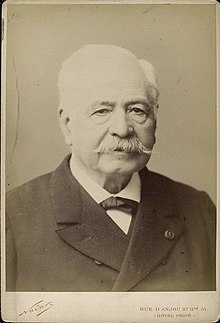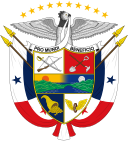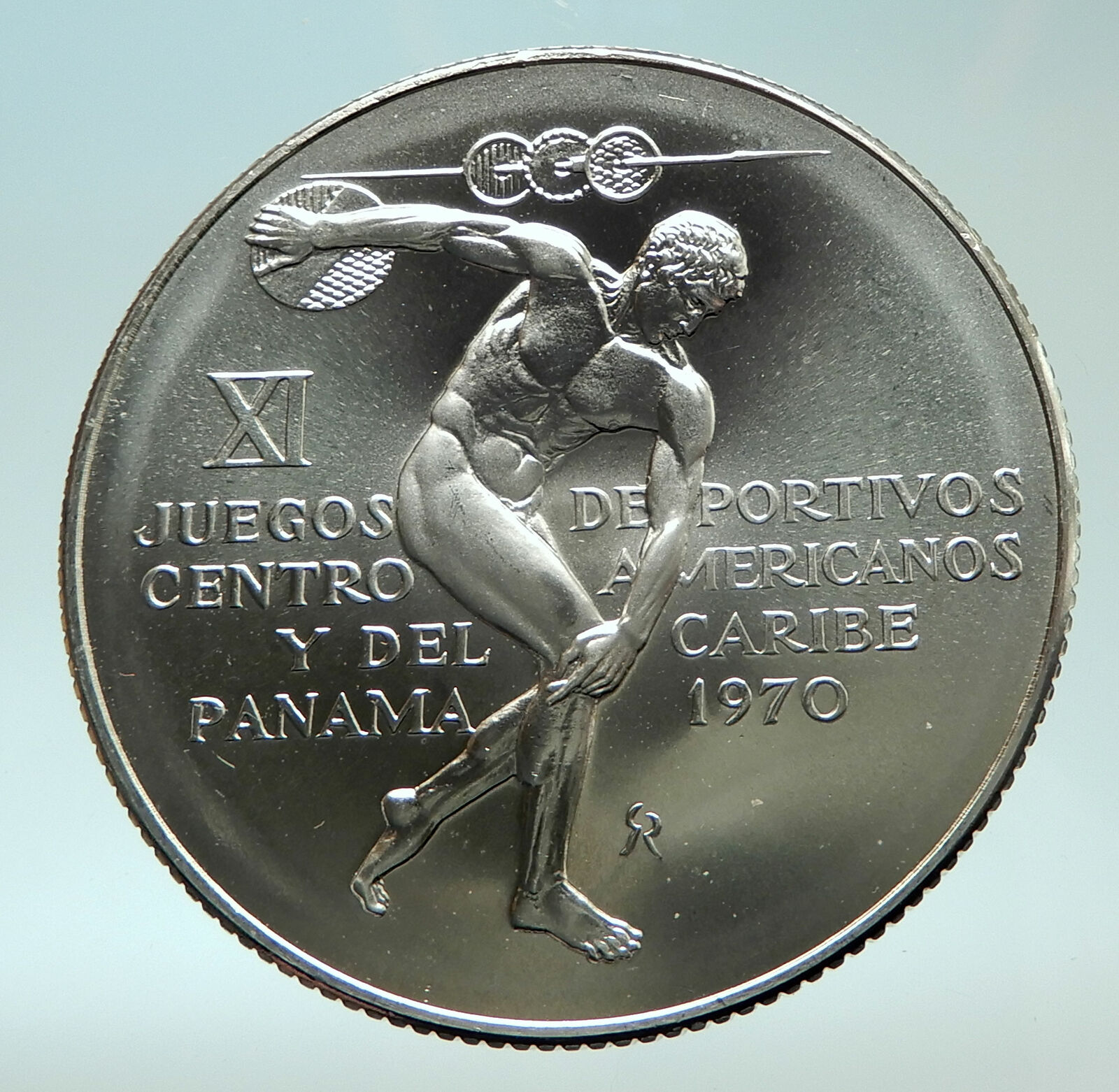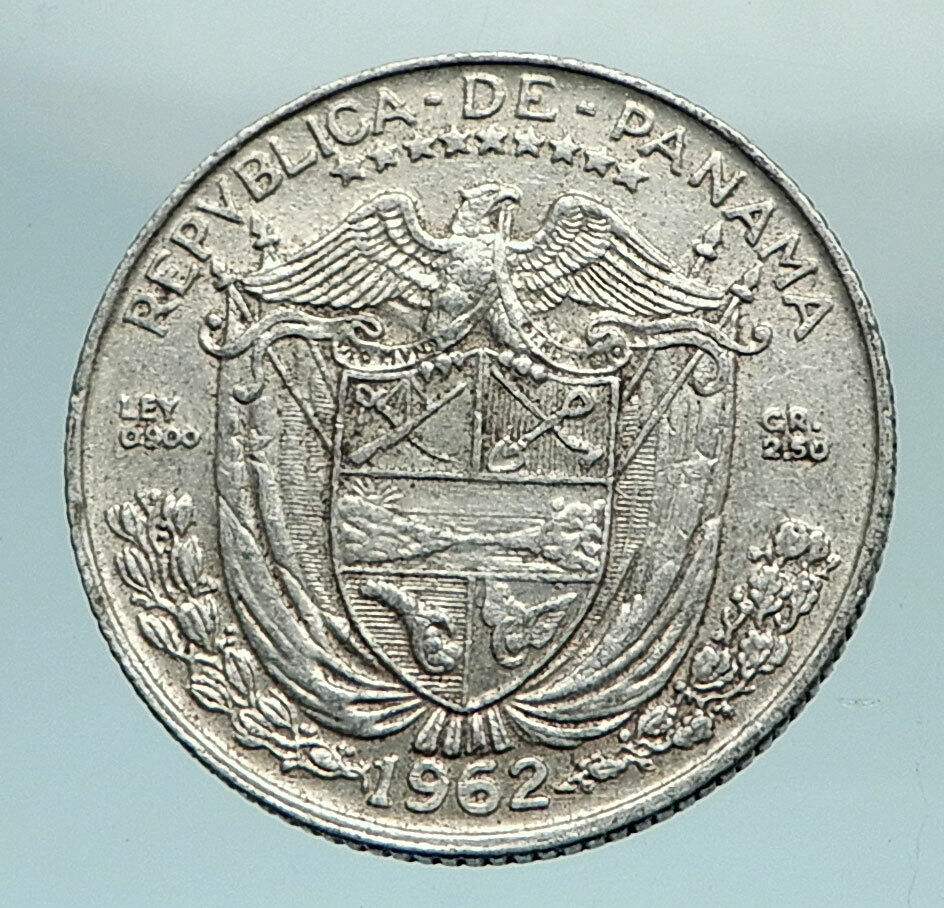|
Panama
1976 Proof Copper-Nickel Clad Copper 50 Centésimos 30.67mm (10.87 grams)
Reference: KM# 38 (1975-82)
REPUBLICA DE PANAMA PRO MUNDI BENEFICIO FM 50 CENTESIMOS, Coat-of-arms
with nine stars above.
FERNANDO DE LESSEPS 1975, Portrait 3/4 left of Ferdinand de Lesseps.
You are bidding on the exact item pictured, provided with a Certificate of Authenticity and Lifetime Guarantee of Authenticity.
 Ferdinand Marie, Count de Lesseps (19 November 1805 – 7 December 1894) was a French diplomat and later developer of the Suez Canal, which in 1869 joined the Mediterranean and Red Seas, substantially reducing sailing distances and times between Europe and East Asia. Ferdinand Marie, Count de Lesseps (19 November 1805 – 7 December 1894) was a French diplomat and later developer of the Suez Canal, which in 1869 joined the Mediterranean and Red Seas, substantially reducing sailing distances and times between Europe and East Asia.
He attempted to repeat this success with an effort to build a Panama Canal at sea level during the 1880s, but the project was devastated by epidemics of malaria and yellow fever in the area, as well as beset by financial problems, and the planned Lesseps Panama Canal was never completed. Eventually, the project was bought out by the United States, which solved the medical problems and changed the design to a non-sea level canal with locks. It was completed in 1914.
In May 1879 a congress of 136 delegates (including Lesseps) assembled in the rooms of the Société de géographie in Paris, under the presidency of Admiral de la Roncire le Noury, and voted in favor of the creation of a Panama Canal, which was to be without locks, like the Suez Canal. Lesseps was appointed President of the Panama Canal Company, despite the fact that he had reached the age of 74. It was on this occasion that Gambetta bestowed upon him the title of “Le Grand Français”. However, the decision to dig a Panama Canal at sea level to avoid the use of locks, and the inability of contemporary medical science to deal with epidemics of malaria and yellow fever, doomed the project.
In February 1880, Lesseps arrived in New York City to raise money for the project. When he stayed at the Windsor Hotel, its staff flew the French flag in his honor. He met the American Society of Civil Engineers and the Geographic Society while touring the area. Lesseps then went to Washington D.C., met with President Rutherford B. Hayes, and testified to the House Interoceanic Canal Committee. He later went to Boston, Chicago, and several other American cities to raise interest and capital for the project.
In June 1880, Lesseps gave a speech in Liverpool where he was able to find support from a Captain Peacock, who felt the canal project was worth supporting as it would provide routes to save time.
Lesseps went with his youngest child to Panama to see the planned pathway. He estimated in 1880 that the project would take 658 million francs and eight years to complete. After two years of surveys, work on the canal began in 1882. However, the technical difficulties of operating in the wet tropics dogged the project. Particularly disastrous were recurrent landslides into the excavations from the bordering water-saturated hills, and the death toll from malaria and yellow fever. In the end, insufficient financial capital and financial corruption ended the project. The Panama Canal Company declared itself bankrupt in December 1888 and entered liquidation in February 1889.
The failure of the project is sometimes referred to as the Panama Canal Scandal, after rumors circulated that French politicians and journalists had received bribes. By 1892 it emerged that 150 French deputies had been bribed into voting for the allocation of financial aid to the Panama Canal Company, and in February 1893 Lesseps, his son Charles (born 1849), and a number of others faced trial and were found guilty. Lesseps was ordered to pay a fine and serve a prison sentence, but the latter was overturned by the Court of Cassation on the grounds that it had been more than three years since the crime was committed. Ultimately, in 1904 the United States bought out the assets of the Company and resumed work under a revised plan.
 Panama, officially the Republic of Panama, is the southernmost country of Central America and the whole of North America. Panama, officially the Republic of Panama, is the southernmost country of Central America and the whole of North America.
Situated on the isthmus connecting North and South America, it is bordered by Costa Rica to the west, Colombia to the southeast, the Caribbean to the north and the Pacific Ocean to the south. The capital and largest city is Panama City, whose metro area is home to nearly half of the country’s 3.6 million people.
 Panama was inhabited by several indigenous tribes prior to settlement by the Spanish in the 16th century. It broke with Spain in 1821 and joined a union of Nueva Granada, Ecuador, and Venezuela named the Republic of Gran Colombia. When Gran Colombia dissolved in 1831, Panama and Nueva Granada remained joined, eventually becoming the Republic of Colombia. With the backing of the United States, Panama seceded from Colombia in 1903, allowing the Panama Canal to be built by the U.S. Army Corps of Engineers between 1904 and 1914. In 1977, an agreement was signed for the total transfer of the Canal from the United States to Panama by the end of the 20th century, which culminated on 31 December 1999. Panama was inhabited by several indigenous tribes prior to settlement by the Spanish in the 16th century. It broke with Spain in 1821 and joined a union of Nueva Granada, Ecuador, and Venezuela named the Republic of Gran Colombia. When Gran Colombia dissolved in 1831, Panama and Nueva Granada remained joined, eventually becoming the Republic of Colombia. With the backing of the United States, Panama seceded from Colombia in 1903, allowing the Panama Canal to be built by the U.S. Army Corps of Engineers between 1904 and 1914. In 1977, an agreement was signed for the total transfer of the Canal from the United States to Panama by the end of the 20th century, which culminated on 31 December 1999.
.svg/375px-Panama_(orthographic_projection).svg.png) Revenue from canal tolls continues to represent a significant portion of Panama’s GDP, although commerce, banking, and tourism are major and growing sectors. Panama has the second largest economy in Central America and it is also the fastest growing economy and the largest per capita consumer in Central America. In 2013, Panama ranked 5th among Latin American countries in terms of the Human Development Index, and 59th in the world. Since 2010, Panama remains the second most competitive economy in Latin America, according to the World Economic Forum’s Global Competitiveness Index. Covering around 40 percent of its land area, Panama’s jungles are home to an abundance of tropical plants, animals and birds – some of them to be found nowhere else in the world. Revenue from canal tolls continues to represent a significant portion of Panama’s GDP, although commerce, banking, and tourism are major and growing sectors. Panama has the second largest economy in Central America and it is also the fastest growing economy and the largest per capita consumer in Central America. In 2013, Panama ranked 5th among Latin American countries in terms of the Human Development Index, and 59th in the world. Since 2010, Panama remains the second most competitive economy in Latin America, according to the World Economic Forum’s Global Competitiveness Index. Covering around 40 percent of its land area, Panama’s jungles are home to an abundance of tropical plants, animals and birds – some of them to be found nowhere else in the world.
|





 Ferdinand Marie, Count de Lesseps (19 November 1805 – 7 December 1894) was a French diplomat and later developer of the Suez Canal, which in 1869 joined the Mediterranean and Red Seas, substantially reducing sailing distances and times between Europe and East Asia.
Ferdinand Marie, Count de Lesseps (19 November 1805 – 7 December 1894) was a French diplomat and later developer of the Suez Canal, which in 1869 joined the Mediterranean and Red Seas, substantially reducing sailing distances and times between Europe and East Asia. Panama, officially the Republic of Panama, is the southernmost country of Central America and the whole of North America.
Panama, officially the Republic of Panama, is the southernmost country of Central America and the whole of North America. Panama was inhabited by several indigenous tribes prior to settlement by the Spanish in the 16th century. It broke with Spain in 1821 and joined a union of Nueva Granada, Ecuador, and Venezuela named the Republic of Gran Colombia. When Gran Colombia dissolved in 1831, Panama and Nueva Granada remained joined, eventually becoming the Republic of Colombia. With the backing of the United States, Panama seceded from Colombia in 1903, allowing the Panama Canal to be built by the U.S. Army Corps of Engineers between 1904 and 1914. In 1977, an agreement was signed for the total transfer of the Canal from the United States to Panama by the end of the 20th century, which culminated on 31 December 1999.
Panama was inhabited by several indigenous tribes prior to settlement by the Spanish in the 16th century. It broke with Spain in 1821 and joined a union of Nueva Granada, Ecuador, and Venezuela named the Republic of Gran Colombia. When Gran Colombia dissolved in 1831, Panama and Nueva Granada remained joined, eventually becoming the Republic of Colombia. With the backing of the United States, Panama seceded from Colombia in 1903, allowing the Panama Canal to be built by the U.S. Army Corps of Engineers between 1904 and 1914. In 1977, an agreement was signed for the total transfer of the Canal from the United States to Panama by the end of the 20th century, which culminated on 31 December 1999..svg/375px-Panama_(orthographic_projection).svg.png) Revenue from canal tolls continues to represent a significant portion of Panama’s GDP, although commerce, banking, and tourism are major and growing sectors. Panama has the second largest economy in Central America and it is also the fastest growing economy and the largest per capita consumer in Central America. In 2013, Panama ranked 5th among Latin American countries in terms of the Human Development Index, and 59th in the world. Since 2010, Panama remains the second most competitive economy in Latin America, according to the World Economic Forum’s Global Competitiveness Index. Covering around 40 percent of its land area, Panama’s jungles are home to an abundance of tropical plants, animals and birds – some of them to be found nowhere else in the world.
Revenue from canal tolls continues to represent a significant portion of Panama’s GDP, although commerce, banking, and tourism are major and growing sectors. Panama has the second largest economy in Central America and it is also the fastest growing economy and the largest per capita consumer in Central America. In 2013, Panama ranked 5th among Latin American countries in terms of the Human Development Index, and 59th in the world. Since 2010, Panama remains the second most competitive economy in Latin America, according to the World Economic Forum’s Global Competitiveness Index. Covering around 40 percent of its land area, Panama’s jungles are home to an abundance of tropical plants, animals and birds – some of them to be found nowhere else in the world.




